2.3.1 תרְגיל קְריאה - Reading Practice: "Stop The Music" -
The punctuation marks have been deliberately left out of the reading that follows, in order to force you to think about the meaning, as you read. Write in the necessary punctuation. Then listen to the audio, paying attention to pauses, etc. to check if you did it correctly (The content of the paragraph is based on dialogue. 2.1.)
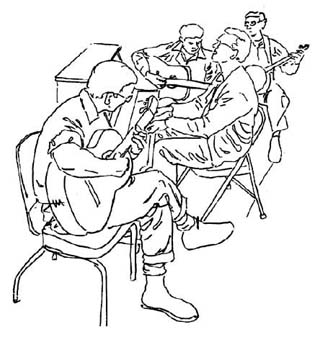
דוד סטודנט אמריקאי הוא יודע קְצת עברית אבל הוא לא מְדבר רינה אמְרה יופי כי היא רוצה ללמוד עם דוד דוד אמר "למדתי לקרוא עברית" הדוד של רינה לא גר בתל-אביב הוא גר באמריקה יחד עם דודה דבורה
Listen to the audio to see if you put in the punctuation correctly.
100.00 %
2.3.2 נכון או לֹא נכון?
Here are some statements about your school/university. Indicate whether you feel they are correct or not. Even though there are unfamiliar words in some sentences, try to guess which response suits you.
100.00 %
![]()
1. כל הפרופסורים בקמפוּס מצוּיינים נכון לא נכון
2
. אֵין סְפרים בסיפְריה (library) נכון לא נכון3. יֵש אוּניבֶרְסיטאות יותר גדולות מֵהאוּניברסיטה שלי ("bigger than") נכון לא נכון
4. הקמפוּס הזה יפה נכון לא נכון 5. באוניברסיטה כוּלם יודְעים עבְרית נכון לא נכון 6. בכיתה שֶלי יֵש יותֵר סטודנטים מִסטודנטיות נכון לא נכון 7. בכיתה יֵש פרופסור וגם פרופסורית; נכון לא נכון
77
2.3.3 עבודה בִּקְבוּצות - Group Work -
100.00 %
Working in small groups is an excellent way to get lots of practice in speaking and listening. As you work together, avoid using English. If you're not sure how to say something - Take risks... After all you're among friends! It is to be expected that beginners will make some mistakes. Please bring a printout of this exercise to class.
And when you forget whose turn it is. Be sure to ask: ?
שֶל מי התורRead these statements aloud. Then declare either:![]()
1.
נכון 2. לא נכון 3. אני לא יודֵעַ 4. אני לא יודעת-
פילדֶלְפיה עיר גְדולה. ______________
-
דוד מִיִשְׂראֵל.
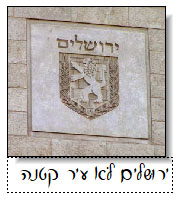 ______________
______________ -
דפְנה מִירוּשלים. ____________
-
דוד למד אֶת האלֶף-בֵית עִם רינה. ______________
-
דוד כתב להורים. ______________
-
רינה כתְבה מיכְתב. ______________
-
רינה מְדבֶּרֶת עִבְרית ______________
-
דוד שכח שֶהוּא מֵאמֶריקה. ______________
-
דוד סְטוּדנט מְצוּיין . ______________
-
רינה מְדבֶּרֶת לְאט מְאוד. ______________
ה
דוד, דפְנה, ורינה סְטוּדֶנְטים באוּניבֶרְסיטה
100.00 %
Reading Hebrew is a skill that takes a lot of practice.
You can speed your progress by using the audio that accompanies this textbook
Reading aloud is always a good idea.
Hint: Some of the /shva/ vowel symbols have been
left out .
78
2.3.4 בְבקשה לענות על השְאֵלות - Answer the questions
These questions are based on dialogue ¶2.1.
100.00 %
1
. מה למד דוד? _____________________2
. האִם דוד יודֵע לִקרוא עברית? _____________________3
. דוד יודֵעַ לִכתוב עברית? _____________________4
. האִם דוד כתב מיכְתב? _____________________5
. איפֹה ההורים של דוד? _____________________6
. מי באמֶריקה? _____________________7
. מי פרופֶסור? _____________________8
. מי אדם חשוּב? _____________________9
. האִם רינה יודעת את האלף-בית? _____________________1
0. מי כתב מיכתב לאבא ואמא? _____________________11
. אֵיפה ירושלים? _____________________1
2. למה דוד לא יודֵעַ עברית ? _____________________100.00 %
Asking Questions 2.3.5
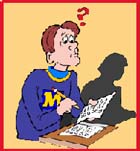 There are a number of words that are used in the
exercise above to start a question.
There are a number of words that are used in the
exercise above to start a question.
How many different words can you find?
Question number two uses the "written question mark"
word - האִם .As you can see from question three, it is not necessary to use
האם and it is usually omitted in conversation.Question number twelve starts with
למה (why). The answer can often begin with the word כִי - "because".For example:
שמוּאל לֹא כתב במחְבֶרֶת כי הוּא לא יודֵעַ לִכְתוב (to write) בְעברית.
or you can start with the answer when replying : כי הוּא לא יודֵעַ לִכְתוב בְעִבְרית.
Shmuel didn't write in the notebook because he doesn't know how to write in Hebrew.
79
2.4 דיקדוּק - ה and דְגֵשים
Reminder about
דְגֵשים and about ה at the end of a word.-
The letters
The letter
2.4.1 תרְגיל Listen and Follow Along Silently
Read this exercise together in class and then repeat it as homework. Listen to the audio or your instructor and respond to the prompts:
This exercise provides practice in training your eye to follow as you hear Hebrew sounded, You are not expected to understand the meaning of all of these words. Train your eye to follow as the words are read. Note the use of yood, vahv, and final heh to indicate vowels.
100.00 %
סוּס, סוּסה, הסוּס, פיל, פילה, כיתה, יום, ים, הים התיכון, דן, חם, חמה, עבודה, על, סימן, קטן, קְטנה, גדול, גְדולה, מיכְתב, כתב, כתבְתי, סוף, מוּל, אוּלי, שֶלי, שֶלְךָ, תורה, הורים
עבודה, על, סימן, קטן, קְטנה, גדול, גְדולה, מיכְתב, כתב, כתבְתי, סוף, מוּל, אוּלי, שֶלי, שֶלְךָ, תורה, הורים
2.4.2 תרְגיל קְריאה - Practice Reading
Look carefully as you proceed! When the audio "dings" read the first sentence aloud, then listen to it being read. After the next "ding" read the next sentence aloud and then listen to it being read. Continue until done.
100.00 %
1.
דן שכח אֶת המילה.2.
הדודה שֶל רינה גרה בְתֵל-אביב.3.
היא מְדבֶּרֶת מהֵר מְאוד וְהוּא לא יודֵעַ עבְרית.4.
הכּיתה גְדולה מִדיי וְאֵין לוּחַ בכיתה80
2.5 הניקוּד - THE COMPLETE SET OF VOWEL MARKS -
Modern Hebrew is usually written without vowel marks
ניקוּד ( See ¶ 1.3)2.5.1 האיוּת בעברית - Hebrew Spelling
You will encounter Hebrew words outside this book that are spelled differently from the spelling rules followed here. Modern Hebrew spelling is in a transitional phase moving away from a style that was closer to "biblical" spelling. It has not yet stabilized
completely. This textbook is more consistent in its use of the yood and vahv as vowel letters, than some of the more conservative Israeli writers. It is still common to find Israelis who adhere to a spelling style that is closer to the spelling used in a fully pointed, i.e. fully vowel-marked text. They refrain from writing a yood or vahv in places where we have chosen to employ these newer spelling strategiesNevertheless, you will find that in this textbook, we too, have occasionally chosen to maintain a conservative spelling. For example in the short words "if "
אִם and "with" עם , personal names and the word עברית.
2.5.2 הניקוּד - Vowel marks and vowel sounds
As you have learned, Hebrew has five vowel sounds: /ah/ /eh/ /ih/ /oh/ /oo/. However, there are more than five symbols to represent these vowel sounds. As the chart below shows, there are a number of different symbols which today represent the same vowel sound. The reasons for this situation are historical and need not be discussed here. For now, you only need to know that the different vowel symbols listed in each row of the chart are pronounced alike.
The alef is not a silent letter. It is used to represent
a vowel. When written with nikkud the alef
/א/
has the sound of the nikkud (vowel) symbol associated with it.
100.00 %
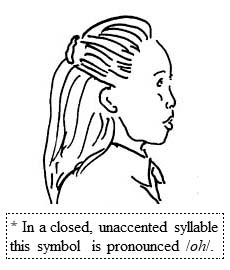
Vowel Sound Hebrew Symbols
אַ אֲ אָ
= /ah/אֶ אֱ אֵ
= /eh/אִ אִי
= /ih/ee/או אֹ אׇ
* אֳ* = /oh/אוּ אֻ
= /oo/בְ
= (Example: when the shva is pronounced.) /beh/For the names of the vowel symbols, see Appendix D.
81
2.5.3 שְווא The Symbol for "No Vowel"
100.00 %
The shvah is used in two ways:
1. To indicate a cluster of consonants: two consecutive consonants (in the same syllable) with no vowel between them.
כְלִי
utensil kleeסְתָם
merely stahmבְרוש
cypres brohshWithout the
שְווא in the last word, you might have read it /bah-rohsh/ (inserting a vowel between the ב and the ר.When the sequence of sounds in the cluster make it difficult or impossible to not pronounce a vowel between the consonants, then the shva is pronounced like /eh/. For example:
רְכוּש /reh-xush/ "possessions" or כְגון /keh-gohn/ "for example".2. To mark a closed syllable
: מלְכּוֹ /mahl-koh/ not /mah-lah/xoh/Note: The final
ך can also have vowel marks: ךְ or ךָ. Note that here the vowel marks are not below the letter. מה שִמְךָ מה שְמֵךְ2.5.4 אוצר מילים - Building Vocabulary
![]() Use with Software Chapter 2:5 "Vocabulary
for Speaking and Writing"
Use with Software Chapter 2:5 "Vocabulary
for Speaking and Writing"
Match the word to the Pictured Objects. Say the words out loud. Pay special attention to your vowel pronunciation.
מיכְתב בקְבּוּק כֶּסֶף סֵפֶר מחְבֶּרֶת שיר עֵט עיפרון
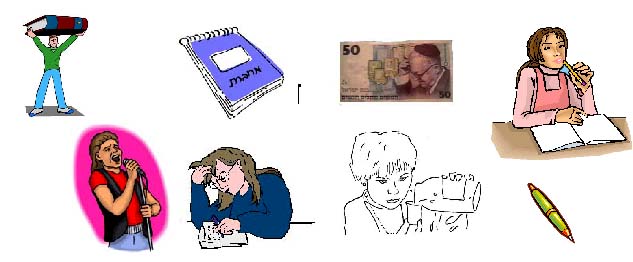
82
הֶעָרָה
FYI לידיעתך
If you need to pause to prepare your answer, you should press the pause "button" on the player and give your answer.
Then press play to hear the next question.